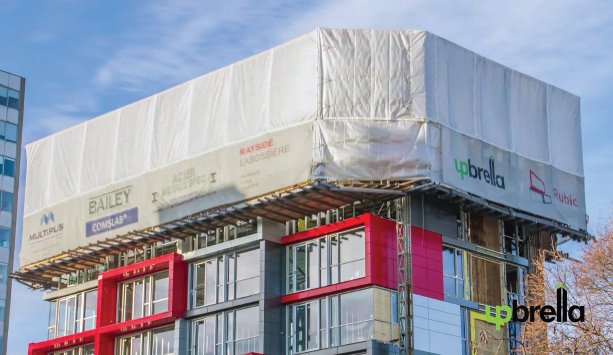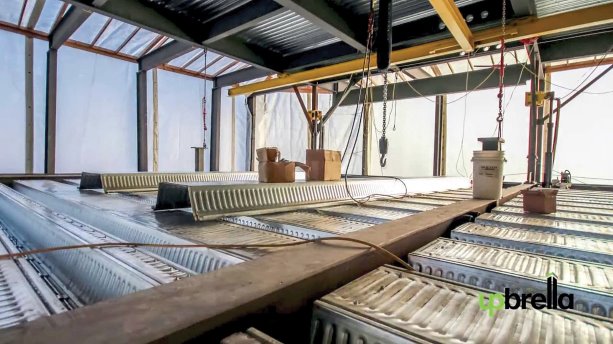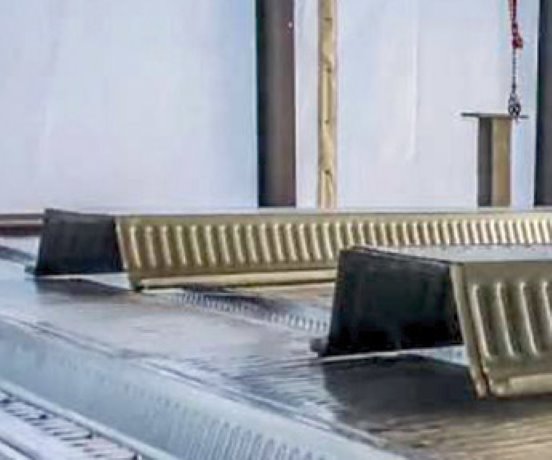Upbrella Construction, inventor of a patented crane-less building system, has been named winner of PWC Canada’s 2017 Vision to Reality Innovator of the Year Award in the Under $25-million Disruptors category.
The system uses telescopic elevator-style lifting actuators and a protective roof enclosure to fully construct one floor at a time behind weatherproof barriers, providing a safer and more protected working environment and virtually eliminating bad-weather delays on jobsites, explained Upbrella president Joey Larouche.
The PWC (formerly Price Waterhouse Coopers) award citation noted, "Upbrella Construction improves the quality, security and construction of highrise construction with their crane-less roof technology. Upbrella highrise construction starts with the roof and doesn’t need a tower crane. The workers, the building and the neighbours are fully protected all the time allowing the finish and delivery of the first floors much faster."
Larouche developed the system with his cousin Justin Larouche and father Gilles Larouche through their Brossard, Que.-based construction company. Upbrella has spent $1.5 million so far in research and development. He said awards are important in signalling to the construction sector that effective new technology should be embraced.
"People in construction are extra conservative," Larouche said.
"General contractors have been working their recipe for decades, they don’t want to change. The partners first discussed collaborating on new construction technologies at a family reunion in 2008 and the new company was founded that same year. Cousin Justin brought startup expertise, Gilles had decades of construction experience and he had developed expertise in lifting systems during his career as a mechanical engineer, Joey Larouche explained.
But product development could not be rushed and the first three years were spent consulting and developing software, 3-D models and prototypes.
Their first project, a self-developed six-storey mixed-use building that went up in Longeuil between 2011 and 2013, tested elements of the Upbrella system but not enough to call it a true pilot project, Larouche said. Financing was the problem.
"It’s tough for startups, especially in construction," he said.
"It’s not a sexy industry for investors so we had to work very hard, more on financing than on R and D, to be honest."
Finally came the breakthrough, in 2014. The Rubic is a 12-storey mixed-use project on Rene-Levesque Boulevard in Montreal. Investissement Poirier became a backer and partner and the project, now complete, became a showcase for the fully developed Upbrella system.
Heads were turned, especially when a time-lapse video covering the build was posted on a CBC website.
There are now three more projects in the works, each with an estimated 2018 start.
Key components to the lifting system, Larouche explained, are multiple sensors and a central panel that ensures all 20 or 30 cylinders lift each completed platform within three millimetres of synch. The maximum lift capacity is 15 tonnes.
The protective enclosure is the key to many benefits of the system. The enclosure enables better collaboration between different teams of workers, said Larouche, and engineers and inspectors can check out the progress of work up close, ensuring better quality. And of course materials are kept dry and workers are protected, Larouche noted.
"Safety, because the system eliminates three of the major problems that we see in open air — objects falling, people falling and damage from weather," said Larouche.
Cranes are found only in the materials-handling system, which transfers tools and construction materials from street-side up the side of the building to the work platform, which is protected by the extended enclosure. A jib crane is used at street level to move materials and a bridge crane moves supplies at the top.
Larouche expects cost savings, and the ability to measure gains such as the greater energy efficiency introduced when there are not 500,000 BTUs of heat being wasted on an open-air build, to become more quantifiable as time goes on. But given that bad weather hampers construction schedules an estimated 20 per cent of the time, the savings due to Upbrella’s protected work environment are significant in calculations right off the top.
"There is much more we can do. Like any new product or technique, the first time you do it is a prototype," he said.
"The second time you do things, they are done in many different applications, you typically cut the costs by one third.
"What we learned from the first project, the second will be much better, the first five projects there is going to be major improvement from one to the other." anything.
"So it is very important for us to have the support of all the people we can have."

1/2
Photo: Upbrella/Youtube
2/2
A screen capture of a YouTube video shows progress on Upbrella’s 12-storey Rubic project and illustrates how the firm’s protective enclosure permits work to proceed inside a weather-tight environment. The system has proven to improve site collaboration and safety.
Photo: Upbrella/Youtube"










Recent Comments
comments for this post are closed